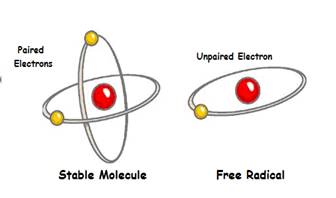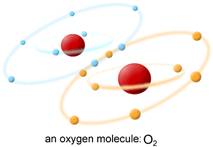Meet Dr. ROS Jeckyll and Mr. ROS Hyde

So exactly what is a Free Radical? Free radicals have become a subject of great interest due to their implication in numerous diseases, including rheumatoid arthritis, Alzheimer's disease, high blood pressure, atherosclerosis, liver cell injury and cancer.
- A free radical (also called just a radical) is a small ion or molecule with one or more unpaired electron in its outer orbital(s) making it highly reactive and likely to take part in chemical reactions with your body's proteins, lipids, carbohydrates and DNA. Electrons within atoms and molecules occupy orbital spaces, in which each orbit holds a maximum of two electrons. Electrons prefer to exist in pairs, and if an electron does not have a "mate" with which to share its orbital space, it will endeavor to "steal" one from another atom (technically, it will oxidize another atom). A radical can have more than one unpaired electron.

- A free radical is formed by:
• The loss or addition of an electron from a stable molecule
• A normal molecule splitting into two fragments - each retaining one of a previous pair of electrons. This is not common in the body, since it needs high energy input E.g. UV, ionizing radiation.
- A newly formed free radical quickly "steals" an electron(s) from a nearby molecule. This satisfies its need for a pair (or pairs) of them in its outer orbital(s), thereby turning its "victim"into a free radical. A chain reaction is thus proliferated, resulting in the disruption of a living cell.
- Free radicals can have positive, negative or neutral charge. Identity as a radical only concerns the arrangement of its electrons in its outer orbital(s). Charge is determined by the difference between the number of protons and electrons. E.g. A neutral molecule could have gained or lost an electron. A non-neutral molecule could become neutral with the addition or loss of an electron.
Free radicals are frequently denoted by a dot placed immediately to the upper right of the atomic symbol or molecular formula. Example free radicals include:
• Cl•
• Hydroxyl Radical (OH•)
• Nitric Oxide (NO•)
• Peroxynitrite (OONO•)
• Alkoxyl Radical (LO•)
The most important free radicals in the body are derivatives of oxygen. However, radicals can also be non-oxygen-centered:
• Carbon-centered radicals. E.g. CCI3• arises from the attack of an oxidizing radical on an organic molecule;
• Hydrogen centered radicals. Result from attack of the H atom (H•);
• Sulfur-centered radicals. Produced in the oxidation of glutathione resulting in thiyl radical (R-S•);
• Nitrogen-centered radicals. E.g.phenyl diazine radical.

The oxygen molecule found in the air we breathe is chemically written as 3O2. The "2" in 3O2 refers to the two chemically bonded oxygen atoms which make up an oxygen molecule. The "3" refers to it being in the triplet or ground state, meaning its outer (valence) electrons are spinning in parallel, i.e. in the same direction, in separate orbitals.
The 3O2 molecule found in the air, is not very reactive because it is a di-radical. So named because it has two electrons in different orbitals without a "mate", making it "hungry" for two electrons (e-). In fact, the oxygen molecule has TWO unpaired electrons WITH PARALLEL SPINS. This makes 3O2 very unlikely to participate in reactions with our body's organic molecules, since organic (i.e. carbon based) molecules that serve as substrates for oxidation do not contain unpaired electrons with their bonds in stable form, having two electrons with antiparallel spins (Pauli's exclusion principle only allows 3 O2 to be an oxidant in the rare case that the reductant (the molecule supplying the electrons) also has two unpaired electrons, with parallel spins opposite to that of oxygen).
This keeps us from spontaneously combusting in our oxygen atmosphere!
The usefulness of the 3O2 oxygen molecule, with its two unpaired electrons, is in its ability to be "activated" to produce more reactive molecules than itself. These are called Reactive Oxygen Species (ROS).
E.g. the very reactive Singlet oxygen (1O2* ) is produced when one of oxygen's electrons does a spin flip and jumps to a higher orbital following absorption of energy, or oxygen can be activated by receiving single electrons by chemical transfer, as in metabolism.
ROS are absolutely necessary for day-to-day functions in the body. E.g. ROS are part of the process of digesting food, necessary for generating of ATP (cellular energy); Immune system macrophages and neutrophils use ROS to destroy foreign organisms
ROS can be toxic to cells. Proteins, membrane lipids, carbohydrates and nucleic acids (DNA, RNA) are subject to cellular damage by ROS, and are implicated in many chronic diseases.
- ROS can be the direct cause of a disease state (e.g. atherosclerosis, by irritating/damaging vascular lining).
- In other cases such as rheumatoid arthritis, ROS mediate and perpetuate cellular damage
- Various stimuli, such as radiation, inflammation, aging and high concentrations of oxygen greatly increase the rate of formation of ROS.
ROS are removed by protective enzymes and antioxidants
( ROS or "Active" Oxygen)
| Biologically significant ROS | ||
|---|---|---|
| (derived from Oxygen, not all are free radicals) | ||
| O2- |
 |
Superoxide radical (anion) |
| OH• | Hydroxyl radical | |
| OH- | Hydroxyl anion (not a radical) | |
| LOO• | Peroxyl radical | |
| LO• | Alkoxyl Radical | |
| H2O2 | Hydrogen peroxide (not a radical) | |
| 1O2 | Singlet oxygen (not a radical) | |
| O3 | Ozone (not a radical) | |
| NO• | Nitric oxide | |
| ONOO- | Peroxynitrite (anion) (not a radical) | |
| HOCl | Hypochlorous acid | |
| LOOH | Peroxide | |
ROS include radicals, ions and peroxides
ROS should not be thought of as "bad". Even though most ROS are free radicals, ROS are formed as necessary intermediates in a variety of normal biochemical reactions in the body.
Although some non-radical ROS are not particularly reactive themselves, they can produce extremely reactive radicals - E.g. Hydrogen peroxide can produce the hydroxyl radical (OH•).
The radicals of most concern to the body are the hydroxyl radical (OH•), alkoxy radical (LO•) and Superoxide radical (O2•-)
ROMs. Reactive oxygen molecular products, such as H2O2, ROOH, ROOR, singlet oxygen, epoxides, endoperoxides and dioxetanes react with some metal ions to produce hydroxyl and alkoxyl radicals, and so may be considered as active ROS
Perhydroxyl radical (OOH•). A powerful oxidant, but its biological relevance is probably minor because of its low concentration at physiological pH.
| Relative Oxidation Power (Cl2 = 1.0) |
|---|
| (Cl2 = 1.0) |
|
Fluorine 2.23 Hydroxyl Radical (OH) 2.06 Atomic Oxygen (singlet) 1.78 Ozone 1.50 Hydrogen Peroxide 1.31 Perhydroxyl Radical (OOH) 1.25 Potassium Permanganate 1.24 Chlorine Dioxide 1.15 Bromine 0.80 |
Chart of ROS and their Metabolites in the Body